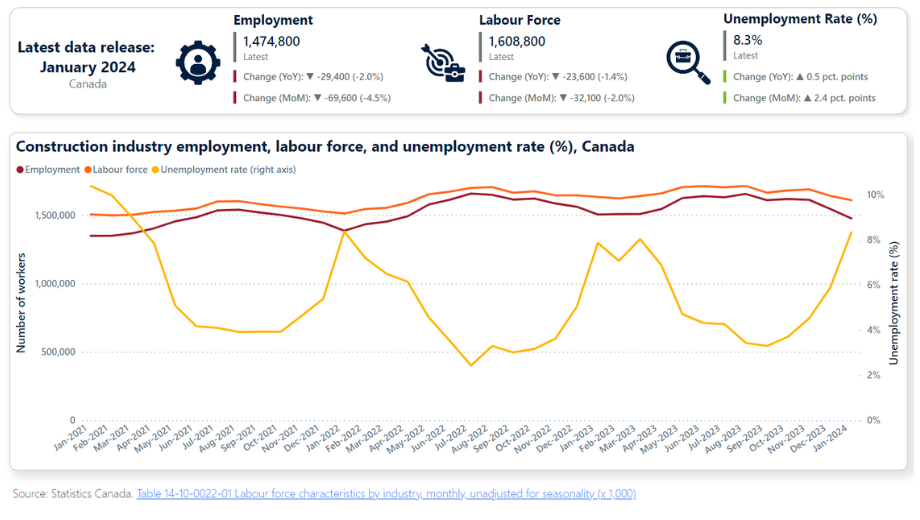Employment figures across all industries in the country increased in January 2024, thanks in part to strong gains among several industries in the services-producing sector.
In its Labour Force Survey for January 2024, Statistics Canada reports that national, all-industry employment rose by 37,000 workers (+0.2%) in January, following three months of little change.
Year over year, overall employment gained 1.7%, with the national, all-industry unemployment rate contracting by 0.1 percentage points, month over month, to reach 5.7%. The decline in that metric was the first reported since December 2022.
Those figures are adjusted for seasonality.
Year over year, construction metrics trend lower; women continue to make gains
Compared with January 2023, seasonally unadjusted data shows construction employment was 2% lower, with 29,600 fewer workers employed. This is likely due to the continued impact of rising interest rates on new-home construction and renovation projects.

Employment losses were reported exclusively among males (-2.9%), while employment among females rose by 8,700 workers, or +4.5%. Gains were most pronounced among women in the core working age group of 25 to 54 years of age, where employment grew by 4,800 (+3.5%) over the last 12 months. Conversely, employment losses were greatest among males in the same age grouping (-22,900; -2.5%).
Year over year, construction’s labour force contracted by 23,600 workers, or -1.4%. Just as with employment, gains among female workers were more than offset by large contractions among males. The greatest increase was reported among core-aged women (+2,400; 1.6%).
Overall, these trends combined to elevate the industry’s national unemployment rate to 8.3% in January 2024 – an increase of 0.4 percentage points compared to January 2023. Despite this, construction unemployment rates for January remain below levels experienced between 2017 and 2022, which averaged 10.4%.
Year over year, employment declined in six provinces. British Columbia reported the largest contraction at -27,900 (-11.2%). Ontario (-8,400; -1.5%) and Quebec (-4,500; -1.6%) followed. Manitoba reported the largest annual gain in employment at 8,200 workers (+1.6%) with New Brunswick and Newfoundland and Labrador following at +7,500 (+30%) and +1,400 (+8.3%) respectively.
Unemployment rates across the provinces in January 2024 ranged from a high of 23.1% in Newfoundland and Labrador to a low of 5.4% in Manitoba. Including Newfoundland and Labrador, five provinces reported rates of 10% or greater. The others were New Brunswick (12.2%), Quebec (11.6%), Saskatchewan (10.6%), and Nova Scotia (10%).

Construction Key Indicators
